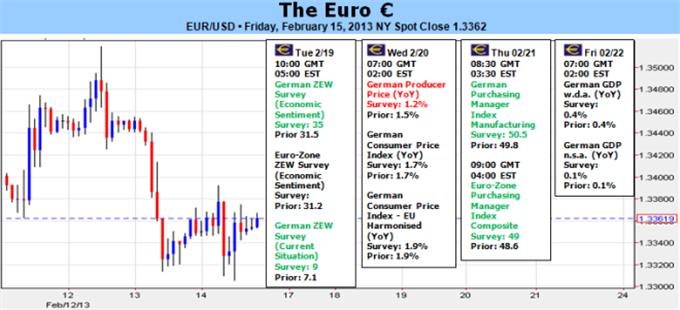
Euro At Risk of Tumble if Sentiment Fails or ECB Softens on Growth
Fundamental Forecast for the Euro: Neutral
Eurozone’s recession deepens with Germany and Greek contracting in the 4Q
EU Minister meeting eases pressure on ECB to act on rising currency
Technical analysis shows EURUSD sinking to support and reversal risk building
The euro was little changed this past week despite a heavy round of event risk that wore away the foundation of the currency’s six-month bull trend. Having advanced nearly 11 percent over the past seven months, EURUSD’s bullish progress is increasingly difficult to sustain. Early in the move, a recovery founded on ‘reduced tail risk’ (positioning accounting for a reduced probability of a Greek exit or further spread of the debt crisis) was easily facilitated as sovereign bond yields slipped and capital was repatriated after the EU’s and ECB’s vows to do what was necessary to ensures stability. Yet, the low hanging fruit is already picked over.
These past months, the catalysts have been more engaged. A positive bearing on general risk trends prevents too many questions of Europe’s troubled future and the ECB’s shrinking balance sheet bolsters yield that attracts investors that have grown complacent and desperate enough to seek out tepid returns on high-risk investments. Yet, both aspects of the currency’s drive are starting to show signs of wear.
The most tangible risk to the euro’s bullish bias moving forward is the possibility that the European Central Bank (ECB) will close ranks with its global counterparts. Since the policy group vowed to pursue an open-ended stimulus program to buy sovereign government debt should debt markets seize – termed the Outright Monetary Transaction or OMT program – back in July, we have seen market confidence rebound and yields drop. In fact, since July, the ECB’s balance sheet has dropped over 10 percent. This has the distinct effect of lifting European market rates which bolsters both capital gains (a rising currency) and yield return.
Threats alone have proven provocative enough to win the region confidence, but improved liquidity for the region is only one aspect for policy officials to concern themselves with. On their official targets core inflation for the Eurozone is below target (1.5 percent), while the unemployment rate has hit a record high (11.7 percent). Furthermore, many of the periphery economies are suffering far more than even these averages would suggest. Spain and Greece, for example, have jobless rates above 25 percent and youth unemployment well above 50 percent. And, the economic malaise is starting to spread as seen in the 4Q GDP reports for Germany (a 0.6 percent drop) and Italy (0.9 percent contraction) amongst other last week.
In the end, there is plenty of evidence that the central bank can point to should it want to ease policy. The question is whether they would take the step. The deterioration in economic health is certainly convincing, and we will be reminded of the trouble this week when the Febraury PMI activity measures – good and timely proxies for official GDP reports – are released. We will also wade back into the liquidity and financial stability considerations as well. This weekend, Cyprus holds its presidential election. The Euro-group had held delayed its decision on if and how to rescue the country until after the elections are settled. Given the severity of Cyprus’ troubles and the constant reassurances that Greece’s rescue was ‘unique’, this may necessitate a very Euro-friendly government to work out.
Also early in the week is ECB President Draghi’s participation in the Quarterly Euro Systemic Risk Board meeting. He has deferred to optimism (as any central banker should), but detail easily undermines a rosy view. The greatest market-mover risk though this week could very well be the announcement of planned prepayments on LTRO (Long-Term Refinancing Operation) loans on Friday. This past Friday, banks announced a sparse €3.8 billion to be paid back – suggesting there is diminished confidence in giving back cheap liquidity. The upcoming announcement differs though because it will represent the first opportunity for banks to start repaying the second round of the three-year LTRO loans that were given in February 2012. If there isn’t another big drain similar to the first, it could temper bullish ambitions. And, lest we forget, Euro traders should always watch broader risk trends. If the S&P 500 collapses, so too will EURUSD. – JK
— Written by: John Kicklighter, Chief Strategist for DailyFX.com
Follow me on twitter at http://www.twitter.com/JohnKicklighter
Sign up for John’s email distribution list, here.
DailyFX provides forex news and technical analysis on the trends that influence the global currency markets.Learn forex trading with a free practice account and trading charts from FXCM.
Source: Daily fx
